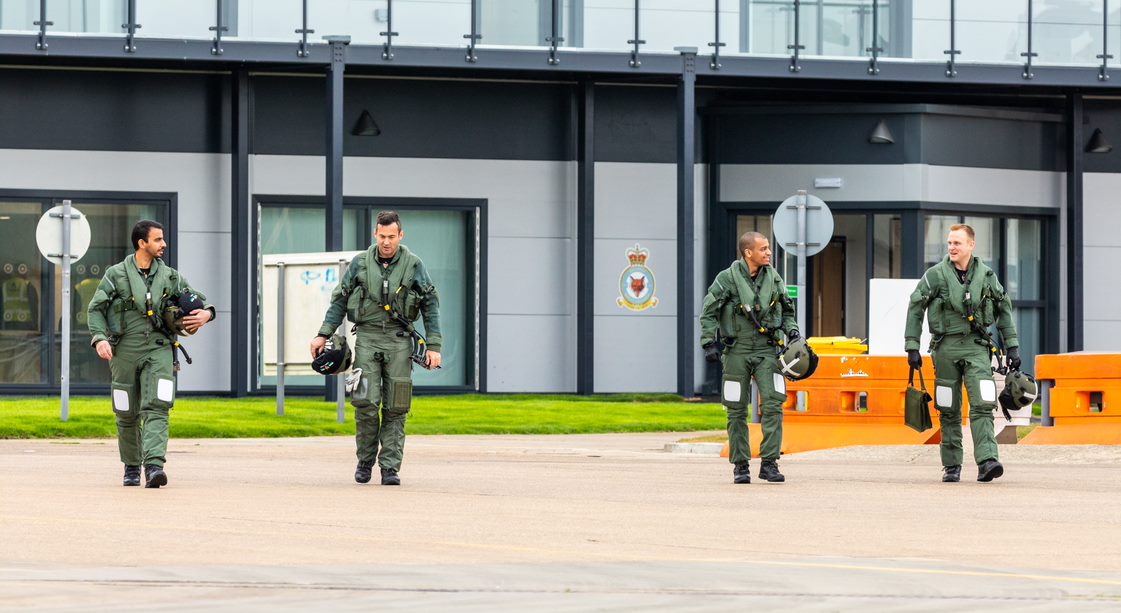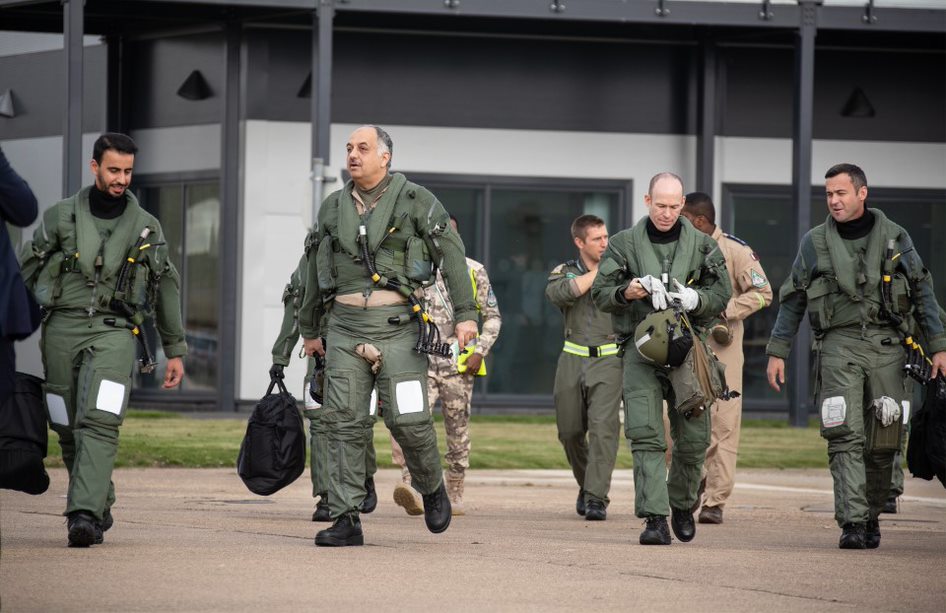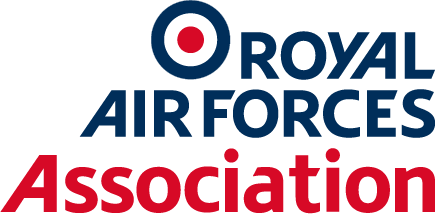Since 2018 the Royal Air Force and the Qatar Emiri Air Force have been developing an ever-stronger relationship; forming 12 Squadron, the UK’s first joint squadron since the Second World War. Three years on we catch up with the British and Qatari personnel at RAF Coningsby to find out how the partnership has progressed, where it’s going next and to hear about 21st century international co-operation.
“Ultimately 12 Squadron doesn’t really exist without our Qatari personnel,” says Squadron Leader Ryan Lawton. He is one of two executive officers (XOs) and is standing next to Captain Ali al Abdulla, his Qatari counterpart, on an overcast summer afternoon at RAF Coningsby in 2021. Today the cloud base is not stopping normal squadron operations and their conversation is against a background of the roar of Typhoons taking off and landing. The air and ground crew are a mix of personnel from each nation. Ryan continues. “It’s just fantastic. The more Qataris we bring on board, on the engineering side and on the pilot side, the greater the opportunities are for all of us.”
The first cohort of personnel from Qatar arrived in June 2020, after a slight delay while the world worked out how to continue to function in a pandemic. Captain Ali al Abdulla describes their arrival: “It was a bit different. The weather here is very different to what we have at home. The most difficult thing was operating during COVID-19 restrictions. It was hard to circulate with our colleagues here and with the RAF.” But as the squadron settled and lockdowns eased, the personnel have gelled well. According to him, the best thing is: “being here in the UK in such a great environment and very high standards. It has added a lot to our experience.”

Captain Ali al Abdulla of 12 Squadron inspects his aircraft before a flight. The experienced Mirage pilot was in the first cohort of pilots and engineers to be trained on Typhoons at RAF Coningsby. © MOD/Crown 2021
How the squadron developed
12 Squadron was officially re-established on 24th July 2018 to become a joint Royal Air Force and Qatar Emiri Air Force squadron, integrating personnel from both nations.
The partnership was set up to boost Qatar’s ability to tackle our shared security challenges in the Middle East, contribute to regional stability and protect the prosperity and security of the UK at home. The Government of Qatar committed to a £6-billion package which includes delivery of 24 new Typhoons and nine new Hawk T2 Mk167 jet trainers from BAE Systems and other suppliers. It also includes a bespoke support package for the RAF to train Qatari pilots and ground crew. The Hawk and Typhoon aircraft ordered by the Government of Qatar are being assembled in the UK, supporting thousands of jobs at locations including BAE Systems’ sites in Warton and Samlesbury until the middle of the decade.
By December 2019, 12 Squadron had completed a three-week exercise in Qatar, flying a number of sorties alongside the Qatar Emiri Air Force (QEAF) as part of Exercise Epic Skies III. The exercise runs annually but this was the first time that the squadron took part. Wing Commander Chris Wright, Officer Commanding at the time said: “The exercise has allowed this new team to test our mettle in a foreign location, following some hard work back at Coningsby since our re-formation, and ahead of the first of our QEAF personnel joining the squadron in early 2020. Just as importantly, our time in Qatar has allowed us to work hard on our cultural awareness and even our Arabic.”
In June 2020, Qatari Minister of State for Defence Affairs, His Excellency Dr Khalid bin Mohammad al Attiyah and United Kingdom Defence Secretary Ben Wallace marked the first joint flights from RAF Coningsby. The flags of both nations were raised, signalling the squadron’s readiness to train pilots and ground crew from both air forces. His Excellency Dr Khalid said: “The raising of the flags side by side in commemoration of the first joint flight represents the alignment of vision and strategy in building for a stable and prosperous future for both nations and the world.”
During the visit, Dr Khalid, a former fast jet pilot who trained at RAF Valley, was flown in a Typhoon to experience first-hand the expertise, skills and professionalism of 12 Squadron.

Walking out to the Typhoon flight line at RAF Coningsby. Captain Ali al Abdulla is second from right. © MOD/Crown 2019
Day-to-day on 12 Squadron
Back with the XOs at Coningsby, we discuss the VIP visit. “His Excellency, as a pilot, he always wants to take the jet and fly it by himself,” says Ali. “Maybe when we deploy back to Qatar and have our own jets then I think he will be willing to fly the Typhoon as a single seater. Having His Excellency here, he saw the way we operate as 12 Squadron and he was impressed about the work we do here and, definitely, his visit was very successful.”
Ali and his fellow cohort-one pilots were experienced Mirage pilots before they arrived for Typhoon training. “Obviously learning a new jet, at the beginning, it’s difficult,” he says. “But after you gain some experience on the jet it gets easier and easier every time.”
Ryan pays tribute to the skill of his Qatari colleagues: “The Typhoon is not too difficult to learn to fly and these guys are obviously very experienced in other aircraft. But the challenges for us are trying to translate what we do in the UK into ways these guys can take back home beyond that. Things like close air support, where you are operating as a single pilot, potentially at night, in poor weather. You’ve got two different radios to manage, both of which can be in your second language, while trying to listen to a joint terminal air controller on the ground who is trying to talk you onto a target with friendly forces in close proximity. It’s about as hard as it gets really. And to do that in a second language is really a credit to these guys. With regards to how we can help with that as instructors, it’s very much down to these guys. They have done so incredibly well and ultimately it’s fresh and new for all of us.”
Exercises
As well as simulator and live training, there have been regular exercises for the squadron in Qatar and the UK. Ryan describes: “the fantastic opportunity to go out to Qatar. The weather is much nicer out there, so that makes things a little bit easier, but it’s a totally different environment to fly in. Qatar is quite a small country so there are some constraints on air space which make things a bit more challenging at times. But to work alongside Ali’s colleagues back home to integrate on the Rafale and the Mirage and ultimately to prepare for when these guys get back to their air force with the Typhoon, is a great opportunity for us as a joint squadron.”
In the UK, exercises have included Cobra Warrior. In autumn 2021 Exercise Magic Carpet will be running – a joint UK/Omani project, which 12 Squadron will join. The RAF tries to expose the Qataris to as many different opportunities as possible, from live strafe at Holbeach Range to live bomb drops at Garvie Island off the coast of Scotland. Ali describes the benefits: “Coming from an ex-Mirage, I had a chance to experience some of that, but I think it will be a new thing for the next guys in Cohort Two to practice this. Taking the experience from our colleagues here, definitely will help us setting up the squadron in Qatar. And using what we learned here and trained here to make it back home with our new squadron.”
There have also been opportunities to train with the squadron’s sister ship, the Type 45 HMS Defender. “To be able to operate alongside her and the carrier strike group in the North Sea is something that is a great opportunity for us as a joint squadron,” says Ryan. “And Ali, I am not sure how much you do with your naval or ground assets back home, but …”
Ali picks up the theme: “Back home, sometimes we practice with the Navy. So definitely seeing how the RAF operates with the Royal Navy here is different. So that will help us, thinking ahead maybe in the future, to integrate more with our other armed forces in Qatar.”
In this particular exercise, the squadron was looking at an air defence scenario. HMS Defender was acting as a control platform for the Typhoons and other assets in the airspace, as well as providing her own sea-based air defence system. The planning and the execution of these sorties are useful. Planning on the ground before we fly ensures everyone gets their training objectives met – the Qataris, the Royal Air Force and the joint assets that were participating.

The tail crest of 12 Squadron, the first international joint squadron since the Second World War. © MOD/Crown 2020
The synthetic environment
The RAF trainers try to use a blend of synthetic and live flying throughout. To introduce a new training phase – Ali and his Cohort One colleagues were learning to be pairs lead instructors on the squadron when we spoke – they will be given some phase briefs, learn in the simulator, practice in the simulator, then go into the air to rehearse there. There is a set structure: flying a couple of waves a day, morning and afternoon, with some simulations thrown in as well. Ryan explains: “It’s just about trying to integrate these guys into the squadron as much as possible, so trying to bring them into the planning and debriefing process as much as possible as well. The synthetic environment gives us a great opportunity to really cement the basics, so we can concentrate on processes, work cycles, etc so we are not wasting time and resources airborne, trying to learn something that we could do on the ground. I think synthetic is a great tool initially. It doesn’t quite replicate exactly how the aircraft works, and I know these guys are going to get some pretty decent synthetic devices back home in Qatar. But ultimately you are never going to be able to fully recreate what it’s going to be like to fly in a real aircraft, in poor weather, with real air traffic control, and the physiological effects of flying a Typhoon as well.”
Comparing training in the simulator to live flying, Ali said: “The synthetic actually is very helpful because it’s not like the live – when you just have one hour and 30 in the live mission. In the synthetic if you get something wrong you can just stop and rewind and start from the beginning and definitely you can fly more on the synthetic than live. The synthetic helps a lot, especially during the first phase of learning and at the beginning of each phase.”
RAF Coningsby is waiting for the arrival of the Typhoon Future Synthetic Training Devices which are being built now. As the Qatari Air Force sets up its own, new 7 Wing, it will also be equipped with this latest hardware and software, at an identical training facility in The Arabian Gulf.
Cultural exchange
The RAF has always given opportunities to travel the world and learn about different cultures. The depth of international co-operation experienced in 12 Squadron possibly brings even more global experience to individuals. After Exercise Epic Skies III, Senior Aircraftman (Tech) Sam Melling said: “This has allowed me to start understanding Qatari culture. When we were looking around the Corniche [in Doha] one of the locals invited us onto a boat and talked us through the traditional way of boat building. I believe going forward these personal experiences will help us to create stronger bonds between the RAF and the QEAF.”
Ryan describes how this has continued: “This has very much been a two-way stream. While the instruction and mentoring on how to fly the aircraft and operate the aircraft and engineer the aircraft is probably quite one-sided from the RAF to the Qataris, actually working together as a joint squadron has been a two-way stream. Yes, we are trying to introduce these guys into how an RAF squadron works, but on the flip side, we have learned an awful lot from these guys in how to manage a joint squadron and the cultural aspects of it. The way we socialise, the way we integrate as a squadron, has been a real opportunity for us to get to know these guys better. It means we are much better placed to understand how to operate in the Arabic world.”
When asked about the number of foxes on station (from door knockers on the XO’s office to taxidermy almost everywhere). Ali and all the Qatari personnel we spoke to say they hadn’t really noticed them. It could be they were bringing their exquisite Middle Eastern manners into play about the different ways of displaying the squadron emblem or that they have quite enough to do already – improving their technical English and learning to fly and look after multimillion-pound aircraft in a cold damp country.

Left to right, Colonel Faisal Al-Ghanim Co-commander of 12 Squadron, His Excellency Dr Khalid Qatar Minister of State for Defence, and Group Captain Matt Peterson RAF Coningsby station commander walking with colleagues to 12 Sqn pax flight. © MOD/Crown 2020
The future
In October 2020 and April 2021, the two nations agreed to build on the partnership and establish an additional joint squadron. As part of the agreement, RAF Leeming in North Yorkshire will become the British base for the new UK-Qatar joint Hawk training squadron, using Qatar’s own new Hawk T2 variant aircraft.
Providing valuable training opportunities for both nations, the updated defence agreement will also see the RAF Voyager tanker deploy to Qatar to periodically provide air-to-air refueling training for the QEAF’s fleet of fast jets.
The Voyager fleet already supports defence activity around the world and the Qatar air-to-air refuelling service over the next two years will be part of this. The deployments will be planned to co-ordinate with the UK’s operational and training needs and will benefit the RAF by enhancing its interoperability with international personnel and equipment.
Defence Secretary Ben Wallace said: “In the face of new and emerging threats, it is vital we collaborate with our international allies to tackle our shared security challenges. Our long-standing relationship with Qatar exemplifies this.”
The developments are seen as important steps in the ever-growing military international co-operation that joins the QEAF and the RAF. The joint Hawk training squadron is also seen as an integral component in increasing interoperability and coordination between both air forces, leading to closer cooperation and alignment in future military and peacekeeping efforts.
The formation of the second UK-Qatar joint squadron, which was initially announced in 2020, will provide additional flying hours for RAF pilots and see long-term international investment in new infrastructure and training facilities at RAF Leeming. This will include a Hawk training simulator, and the refurbishment of existing facilities.

With Tattershall Castle, Lincolnshire, behind: Squadon Leader Ryan Lawton, left, with Colonel Faisal Al-Ghanim. © MOD/Crown 2020
What next in Qatar?
When their training in the UK is finished, Ali and his colleagues will return to Qatar: “Next for me is to be able to deliver whatever I learn here in the United Kingdom, back home, and instruct on the platform for the young guys. Our colleagues in the RAF, they have very valuable experience in operating the Typhoon. The Qatar Air Force will receive the Typhoon next year, in 2022, and having 12 Squadron deployed to Qatar next year definitely will help us setting up our new squadron there, back home.”
Standing up the QEAF 7 Wing “will be a great moment” according to Ali. “Already having the Rafale squadron in Qatar, that will help protecting our airspace. But the Typhoon squadron will, I think, be the spine of our air force.”
“the Typhoon squadron will be the spine of our air force”
Main image: the Qatar Emiri Air Force display team in front of the Doha Corniche in 2018. Four RAF Typhoon FGR4’s from Number 29 Squadron, RAF Coningsby, travelled to Doha to participate in this Qatari National Day flypast. © MOD/Crown 2018
Air Mail
A longer version of this article is in the October-December 2021 issue of Air Mail magazine, the RAF Association’s quarterly members’ magazine. To receive this regularly, become a member and opt for Air Mail as part of your membership.




